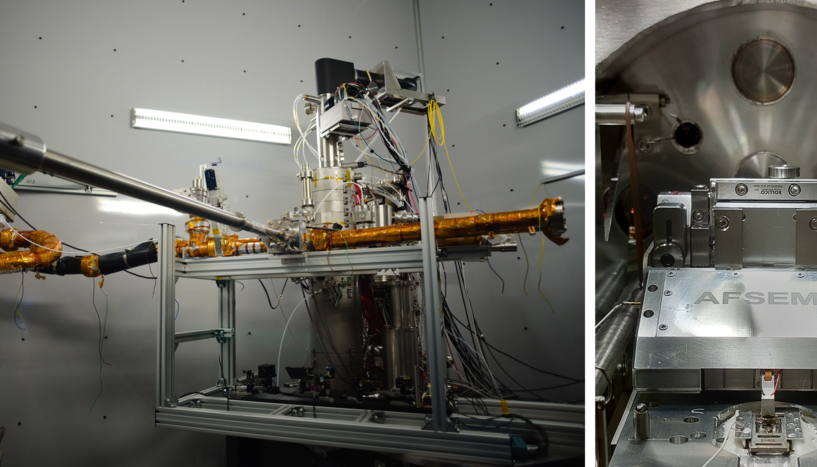Physicists at the University of Vienna, under the direction of Jani Kotakoski, have employed a globally unique technique to significantly enhance the stretchability of graphene for the first time by creating an accordion-like ripple effect. This advancement opens up new possibilities for applications that require specific levels of stretchability, such as wearable electronics. The study was published in the journal Physical Review Letters.
 Photographs of the utilized microscopes. Left: The 3 metres high, scanning transmission electron microscope Nion Ultra STEM 100 by Bruker Corporation connected to the rest of the system via airless metal tubes. Right: View into the airless chamber containing the 11cm wide, atomic force microscope AFSEM by Quantum Design GmbH. Image Credit: : Wael Joudi, Jani Kotakoski
Photographs of the utilized microscopes. Left: The 3 metres high, scanning transmission electron microscope Nion Ultra STEM 100 by Bruker Corporation connected to the rest of the system via airless metal tubes. Right: View into the airless chamber containing the 11cm wide, atomic force microscope AFSEM by Quantum Design GmbH. Image Credit: : Wael Joudi, Jani Kotakoski
When graphene was first demonstrated experimentally in 2004, it created a whole new class of materials known as two-dimensional (2D) solids, because they are only one layer of atoms thick, they have unique material properties that may be useful in various application areas, hence their name.
For instance, graphene is notable for its high electrical conductivity but also extremely stiff. The material's atoms are arranged in a honeycomb pattern, giving it extreme stiffness.
It makes sense that removing some atoms from the material along with their bonds would result in less stiffness. Scientific research, however, has documented both a modest decline and a notable rise.
Scientists have now resolved these contradictions with new measurements. Modern devices were used in the experiments and housed in the same ultra-clean, airless environment. As a result, samples can be moved between the various devices without contacting outside air.
“This unique system we have developed in the University of Vienna allows us to examine 2D materials without interference,” explained Jani Kotakoski.
For the first time, this kind of experiment has been carried out with the graphene fully isolated from ambient air and the foreign particles it contains. Without this separation, these particles would quickly settle on the surface, affecting the experiment procedure and measurements.
Wael Joudi, Study First Author, University of Vienna
The accordion effect, which affects graphene's stiffness, was discovered due to the emphasis on meticulous surface cleanliness: removing two nearby atoms causes the initially flat material to bulge noticeably. When multiple bulges are combined, the material becomes corrugated.
You can imagine it like an accordion. When pulled apart, the waved material now gets flattened, which requires much less force than stretching the flat material and therefore it becomes more stretchable.
Wael Joudi, Study First Author, University of Vienna
Wave formation and the resulting stretchability are confirmed by simulations conducted by Vienna University of Technology Theoretical Physicists Rika Saskia Windisch and Florian Libisch.
The experiments also demonstrated that foreign particles on the material surface cause the opposite effect, in addition to suppressing it. In particular, their influence gives the impression that the material is stiffer, which also explains historical contradictions.
This shows the importance of the measurement environment when dealing with 2D materials. The results open up a way to regulate the stiffness of graphene and thus pave the way for potential applications.
Wael Joudi, Study First Author, University of Vienna
The Austrian Science Fund (FWF) provided full or partial funding for the study.
Journal Reference:
Joudi, W., et al. (2025) Corrugation-Dominated Mechanical Softening of Defect-Engineered Graphene. Physical Review Letters. doi.org/10.1103/physrevlett.134.166102.